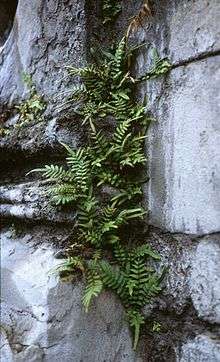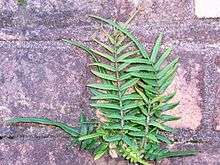Pteris vittata
Pteris vittata, commonly known variously as the Chinese brake,[3] Chinese ladder brake,[3] or simply ladder brake,[3] is a fern species in the Pteridoideae subfamily of the Pteridaceae.[4] It is indigenous to Asia, southern Europe, tropical Africa and Australia.[3] The type specimen was collected in China by Pehr Osbeck.[1]
| Pteris vittata | |
|---|---|
 | |
| Scientific classification | |
| Kingdom: | Plantae |
| Clade: | Tracheophytes |
| Class: | Polypodiopsida |
| Order: | Polypodiales |
| Family: | Pteridaceae |
| Genus: | Pteris |
| Species: | P. vittata |
| Binomial name | |
| Pteris vittata | |
| Synonyms[2] | |
Habitat and distribution
Pteris vittata is native and widespread in the paleotropics: found from the east, to the south tropical, and southern Africa (in Angola; Kenya; Lesotho; Malawi; Mozambique; Namibia; Tanzania (including the Zanzibar Archipelago); Cape Province, Free State, KwaZulu-Natal, and Transvaal in South Africa; Swaziland; Uganda; Zambia; and Zimbabwe); temperate and tropical Asia (in the provinces of Anhui, Gansu, Guangdong, Guangxi, Guizhou, Hubei, Jiangxi, Sichuan, Xizang, and Yunnan in China; the prefectures of Honshu, Kyushu, Shikoku, and the Ryukyu Islands of Japan; and Thailand); and Australia, in the states of New South Wales,[5] Queensland, Victoria, and Western Australia.[3]
Pteris vittata is often associated with limestone habitats. It may be seen growing on concrete structures and cracks, in buildings in the central business district and suburbs of Sydney, Australia.[5][6] It is an introduced species in California, Texas, and the Southeastern United States.[7]
A remnant population exists in the Italian peninsula, in Sicily, Calabria and Campania.[8]
Uses
Although it grows readily in the wild, Pteris vittata is sometimes cultivated.[3] It is grown in gardens for its attractive appearance,[3] or used in pollution control schemes:[3] it is known to be a hyperaccumulator plant of arsenic used in phytoremediation.[9]
Suggested reading
- Cong Tu and Lena Q. Ma; Effects of Arsenic Concentrations and Forms on Arsenic Uptake by the Hyperaccumulator Ladder Brake, Journal of Environmental Quality doi:10.2134/jeq2002.6410 Vol. 31 No. 2, p. 641-647 (résumé)
References
- Pteris vittata was originally described and published in Species Plantarum 2: 1074. 1753. "Name - Pteris vittata L." Tropicos. Saint Louis, Missouri: Missouri Botanical Garden. Retrieved November 3, 2011.
- "Name - Pteris vittata L. synonyms". Tropicos. Saint Louis, Missouri: Missouri Botanical Garden. Retrieved November 3, 2011.
- "Pteris vittata". Germplasm Resources Information Network (GRIN). Agricultural Research Service (ARS), United States Department of Agriculture (USDA). Retrieved November 3, 2011.
- Christenhusz, Maarten J. M.; Zhang, Xian-Chun; Schneider, Harald (18 February 2011). "A linear sequence of extant families and genera of lycophytes and ferns" (PDF). Phytotaxa. 19: 7–54. ISSN 1179-3163.
- "Pteris vittata, PlantNET - NSW Flora Online, Retrieved June 23, 2011".
- Les Robinson - Field Guide to the Native Plants of Sydney, ISBN 978-0-7318-1211-0 page 318
- http://plants.usda.gov/java/profile?symbol=PTVI . accessed 9/19/2010
- Giardina G. (2010). Piante rare della Sicilia. Palermo: Università degli Studi di Palermo. ISBN 9788890310836.
- Wilkins, Carolyn, and Salter, Leo. (2003). Arsenic hyperaccumulation in ferns: A review. Environmental Chemistry Group Bulletin of the Royal Society of Chemistry. July 2003 edition.
External links
| Wikimedia Commons has media related to Pteris vittata. |
